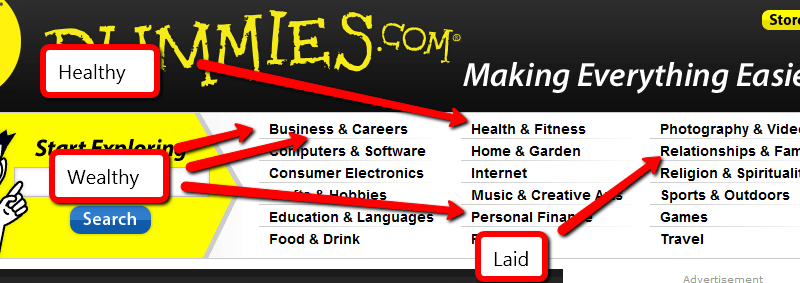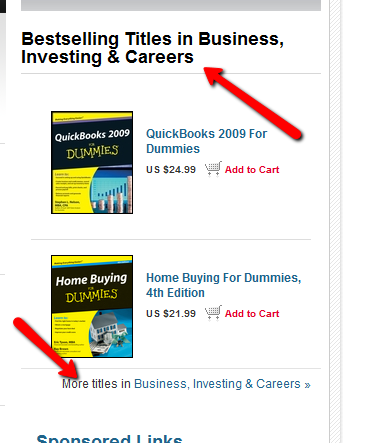This is a conversation between me and my future self, if my financial path wouldn’t have positively forked 2 years ago. The transcript is available here.
What would your future self have to say to you?
The no-pants guide to spending, saving, and thriving in the real world.
This is a conversation between me and my future self, if my financial path wouldn’t have positively forked 2 years ago. The transcript is available here.
What would your future self have to say to you?

If you want to make money, help someone get healthy, wealthy or laid.
This section was quick.
Seriously, those three topics have been making people rich since the invention of rich. Knowing that isn’t enough. If you want to make some money in the health niche, are you going to help people lose weight, add muscle, relieve stress, or reduce the symptoms of some unpleasant medical condition? Those are called “sub-niches”. (Side question: Viagra is a sub-niche of which topic?)
Still not enough.
If you’re going to offer a product to help lose weight, does it revolve around diet, exercise, or both? For medical conditions, is it a way to soothe eczema, instructions for a diabetic diet, a cure for boils, or help with acne? Those are micro-niches.
That’s where you want to be. The “make money” niche is far too broad for anyone to effectively compete. The “make money online” sub-niche is still crazy. When you get to the “make money buying and selling websites” micro-niche, you’re in a territory that leaves room for competition, without costing thousands of dollars to get involved.
Remember that: The more narrowly you define your niche market, the easier it is to compete. You can take that too far. The “lose weight by eating nothing but onions, alfalfa, and imitation caramel sauce” micro-niche is probably too narrowly defined to have a market worth pursuing. You need a micro-niche with buyers, preferably a lot of them.
Now the hard part.
How do you find a niche with a lot of potential customers? Big companies pay millions of dollars every year to do that kind of market research.
Naturally, I recommend you spend millions of dollars on market research.
No?
Here’s the part where I make this entire series worth every penny you’ve paid. Times 10.
Steal the research.
My favorite source of niche market research to steal is http://www.dummies.com/. Click the link and notice all of the wonderful niches at the top of the page. Jon Wiley & Sons, Inc. spends millions of dollars to know what topics will be good sellers. They’ve been doing this a long time. Trust their work.

You don’t have to concentrate on the topics I’ve helpfully highlighted, but they will make it easier for you. Other niches can be profitable, too.
Golf is a great example. Golfers spend money to play the game. You don’t become a golfer without having some discretionary money to spend on it. I’d recommend against consumer electronics. There is a lot of competition for anything popular, and most of that is available for free. If you choose to promote some high-end gear using your Amazon affiliate link, you’re still only looking at a 3% commission.
I like to stick to topics that people “need” an answer for, and can find that answer in ebook form, since I will be promoting a specific product.
With that in mind, pick a topic, then click one of the links to the actual titles for sale. The “best selling titles” links are a gold mine. You can jump straight to the dummies store, if you’d like.
Of the topics above, here’s how I would narrow it down:
1. Business and Careers. The bestsellers here are Quickbooks and home buying. I’m not interested in either topic, so I’ll go into “More titles”. Here, the “urgent” niches look like job hunting and dealing with horrible coworkers. I’m also going to throw “writing copy” into the list because it’s something I have a hard time with.

2. Health and Fitness. My first thought was to do a site on diabetic cooking, but the cooking niche is too competitive. Childhood obesity, detox diets and back pain remedies strike me as worth pursuing. I’m leaning towards back pain, because I have a bad back. When you’ve thrown your back out, you’ve got nothing to do but lie on the couch and look for ways to make the pain stop. That’s urgency.
3. Personal Finance. The topics that look like good bets are foreclosures and bankruptcies. These are topics that can cost thousands of dollars if you get them wrong. I hate to promote a bankruptcy, but some people are out of choices. Foreclosure defense seems like a good choice. Losing your home comes with a sense of urgency, and helping people stay in their home makes me feel good.
4. Relationships and Family. Of these topics, divorce is probably a good seller. Dating advice definitely is. I’m not going to detail either one of those niches here. Divorce is depressing and sex, while fun, isn’t a topic I’m going to get into here. I try to be family friendly, most of the time. Weddings are great topic. Brides are planning to spend money and there’s no shortage of resources to promote.
So, the niches I’ve chosen are:
I won’t be building 9 niche sites in this series. From here, I’m going to explore effective keywords/search terms and good products to support. There’s no guarantee I’ll find a good product with an affiliate program for a niche I’ve chosen that has keywords that are both highly searched and low competition, so I’m giving myself alternatives.
For those of you following along at home, take some time to find 5-10 niches you’d be willing to promote.
The important things to consider are:
1. Does it make me feel dirty to promote it?
2. Will there be customers willing to spend money on it?
3. Will those customers have an urgent need to solve a problem?
I’ve built sites that ignore #3, and they don’t perform nearly as well as those that consider it. When I do niche sites, I promote a specific product. It’s pure affiliate marketing, so customers willing to spend money are necessarily my target audience.

Pre-sale preparation and marketing are important, but ultimately, the money comes from how you manage the sale.
How many people will you have staffing the sale? There are a few considerations here. How many people are involved in the sale? How many people can take the time off? It’s best to have three people at the sale at all times. Two people can manage the money while the third plays salesman and security. Staffer #3 is in charge of watching for price-tag swaps or other theft, answering questions, and trying to upsell. It also allows for breaks, which, if you’ve ever spent a day in a garage drinking coffee, is important.
When are you going to be open? You don’t want to open so early you don’t have time to wake up and get ready for the sale, but you don’t want to open so late the professional garage-salers drive past and forget about you. Plan to open sometime between 7 and 9. When will you close? Staying open until 6 will catch most of the after-work crowd, but it makes for a long day, but closing at four cuts out a lot of the late-day shoppers. Our hours were 8-5, which seemed to be a good compromise between a long day and the best sale.
[ad name=”inlineleft”]Don’t be afraid to shut down. The first day of our sale was cold, wet, and miserable. We had to canopies in the driveway, but everything was getting wet, anyway. Traffic was slow and we weren’t enjoying ourselves, so we shut down. Lunch and a nap improved our outlook considerably. At the end of the day, we start packing up, even if people were there. We tried to only pack what they had looked at, and we didn’t try to rush the potential customers, but we did let them know that the sale was ending for the day. The folks who came in half an hour after close on the last day seemed upset that we didn’t unpack everything for their amusement.
Our layout was designed to get everything easily visible while maximizing traffic. The first day, we were confined to the garage and tents, so space was limited. There were baskets under each of the tables. That forced people to crouch and block each other. The second day, we expanded to fill the driveway. Our tables were organized in 3 rows–a “U” shape with a double-wide row of tables in the middle. This allowed people to see everything in one pass. The middle row had periodic breaks so we could move around to help the customers. The pay table was in the middle of one of the outer rows, which let us monitor the entire sale.
Find someone to watch the kids and pets. If you have to keep an eye on your children, you aren’t watching the customers or giving them the attention they need. Your dog–no matter how well-behaved–is a liability. It will be stressed at the people. Some customers will be allergic or afraid. Just don’t do it.
Ideally, you will have someone who isn’t taking money, knows a little bit about most of the merchandise, and isn’t too shy to talk to strangers. His job is to wander around, answer questions, and help people decide if they want an item. He’s the sales-weasel. If he’s pushy, he’ll chase off the customers, but if he’s hiding, he isn’t making any money. Unusual items should have a sign attached explaining why they are special, so the sales-weasel doesn’t have to explain it to everyone.
Every single item should be priced, but not everything needs to be priced individually. We priced all of the movies in a group. “VHS: $0.50 or 5 for $2, DVD $3 or 4 for $10”. Nobody should have to ask what an item costs. If there are multiple people doing a sale together, make sure everyone is using colored price tags to identify who is selling what.
People come to garage sales expecting to find good deals. If they don’t, they’ll leave. Our rule of thumb for pricing was about 25% of retail, with wiggle-room for the item’s condition. New-in-the-box sometimes made it up to 50% of retail. Our goal was primarily to reduce clutter, so a lot of items were priced at 10%. You have to keep in mind that, if you price things too low, people will assume there is something wrong with it and not assign a value in their own minds. Price it at what you would be willing to pay in a garage sale, then mark it up–just a bit–to account for haggling.
People love to haggle at garage sales. It gives them an opportunity to brag about the great deal they fought for. Try to accommodate them. One of the people participating in our sale was selling antiques with a definite value. She didn’t want to haggle on any prices, so we simply hung up a sign that read “All white-tagged prices are firm.” Everyone else was willing to accept almost any reasonable offer. Our most important rule for accepting a price? If you pissed me off, I didn’t budge on price. Insult me, or offer 1/10 of the price, and my defenses go up, bringing your final price with it. Talk nice and use some common sense while haggling, and you got what you asked for.
[ad name=”inlineright”]Could we have maximized the sale more? Probably. I had intended to hang up a sign that simply said “$100” to set a high anchor-price on everything, but I forgot.
Note: The entire series is contained in the Garage Sale Manual on the sidebar.
Update: This post has been included in the Carnival of Personal Finance.
In April of 2009, I told my wife we were either going to straighten out our finances or file bankruptcy. At that time, we had $90,394 in total debt, including $30,000 in credit card debt. It hasn’t been easy, but we are working out way out of that hole. Since then, we have paid down more than $30,000. That’s not $30,000 in payments, but $30,000 less debt. We are now less than $60,000 in debt. We have entirely stopped accumulating more and I don’t remember the last time we carried a new balance on a card or had to use our overdraft protection. Next month, my car will be paid off, 10 months early.
Given my new-found fanaticism, I spent the next 6 months or so evangelizing about our debt repayment. Eventually, I decided to share my thoughts and progress with the world and launched this site on December 1, 2009. Today is my anniversary.
Here we are, 234 posts, 695 comments, and 17, 661 spam later. You all rock. Except the spammers.
To say thank you, I’m giving away a $100 Amazon gift card to some lucky reader. Yes, I rock, too.
There are several ways you can enter the drawing:
1. Subscribe to Live Real, Now, either by RSS or email. If you are already subscribed by email, you are automatically entered. To show me you have subscribed by RSS, there is a contest code in the feed. Just post that in the comments. (1 entry)
2. Follow me on twitter and tweet the following: “@LiveRealNow is giving away $100. Come get some! Follow and RT to enter! http://bit.ly/f1roKM #Giveaway #Yakezie” (1 entry possible per day. Every day you retweet this is another entry!)
3. “Like” LRN on Facebook. This is easy, just click the little ‘like’ button on the left. If you’ve already done that, you have already entered once.(1 entry)
4. Send me an email at Jason <AT> LiveRealNow <DOT> net telling me what you would like to see me write about more (or less!). You can also use the contact form. (1 entry)
I’m closing this down on the 15th. That’s 18 possible entries for $100 you may win early enough to help with some last-minute Christmas shopping.
UPDATE:
And the winner is…Claudia! Congratulations. Email sent.

Today, it is my please to host the 287th Festival of Frugality, the Independence Day Edition. Yesterday, was Independence Day in the US. It’s the day we celebrate throwing off the yolk of high-tax, no-rights tyranny and blowing stuff up.
That’s not what this Festival is about. As much as I love this country and enjoyed celebrating, today, the theme is the Independence Day movie.
Coolest ID4 fact, ever: A promotional piece that aired in Spain for this film set off a “War of the Worlds” type of wide spread panic. The promo featured a popular Spanish news anchor and the piece ran as if there really WAS an alien attack to occur on July 4.
The explosion of the Welcome Wagon Helicopters was actually footage of a pyrotechnics accident on set.
Miss T. gives us Seven Reasons to Avoid Penny Auction Sites. She does a great job of explaining the evil that is Penny Auctions, from outright fraud to the rip-off that is the basic business model. Some of these sites make $5000 or more on an iPad auction. They don’t even have to carry an inventory before running an auction.
Independence Day holds the record for most miniature model-work. It beat the previous record by double.
Philip submits Turn Wasted Extra Money Into a Debt Payment. I have a friend who is positive he can’t reduce his monthly expenses at all, while eating out almost every day.
The alien ship “miniature” was 65 feet across.
Boomer presents Financial Support For Your Adult Children. I love my parents. A lot. I couldn’t imagine moving back in with them, and I’m pretty sure they’d feel the same way soon enough. Although, Mom, if you’re reading this, can I have an allowance again?
This was the highest grossing film in 1996.
Suba presents Why you should not use 401k. I’ve never questioned the wisdom of maxing out a 401k. It’s good to see those assumptions challenged and the numbers crunched.
President Whitmore: Good morning. In less than an hour, aircraft from here will join others from around the world. And you will be launching the largest aerial battle in the history of mankind. Mankind, that word should have new meaning to all of us. We cannot be consumed by our petty differences anymore. Perhaps it is fate that today is the fourth of July, and we will once again be fighting for our freedom. But not for freedom from tyrrany or oppression or persecution. We’re fighting for our right to live, to exist. And should we win the day, the Fourth of July will no longer be known as an American holiday, but as the day when the world stood up and declared in one voice that we will not go quietly into the night! We will not vanish without a fight! We’re going to live on! We’re going to survive! Today we celebrate our Independence Day!
FMF presents Save Money on Groceries by Shopping on Wednesday posted at Free Money Finance.
Harri Pierce presents Have a second hand summer posted at TotallyMoney.
Daniel presents Top 10 Reasons to Shop Online vs. Shopping In-Store posted at Sweating The Big Stuff.
President Whitmore: It’s a fine line between standing behind a principle and hiding behind one.
Philip Taylor presents The Best Time to Buy posted at PT Money Personal Finance.
Outlaw presents Pay Yourself First and Have Money in the Bank posted at Outlaw Finance.
Crystal presents Frugal Tips for the Pet Dog posted at Budgeting in the Fun Stuff.
Matt presents The Price of Water posted at Stupid Cents.
That’s right! That’s what you get! Look at you! Ship all banged up! Who’s the man? Who’s the man?! Wait until I get another plane! I am going to line up all your friends right beside you! ~ Captain Steven Hiller
Alan presents The Cost of Online Gaming: Free to Play posted at Canadian Finance Blog.
Paula @ AffordAnything.org presents Diets and Debt: Managing Money and Your Weight posted at AffordAnything.org.
Kay Lynn presents Summer Fun for the Frugal Family posted at Bucksome Boomer.
Jacob @ My Personal Finance Journey presents Top 10 Money Saving Tips posted at My Personal Finance Journey.
Glen Craig presents The Cost of Clutter on Your Finances and Life posted at Free From Broke.
Eddie presents 55 Suggestions To Save $1000 posted at Finance Fox.
Darwin presents Are You Better Off Than Your Parents? posted at Darwin’s Money.
Sustainable PF presents Sustainability Tip #179: Loose Cap Lose Gas posted at Sustainable Personal Finance.
WHOOOOO!!!!!!!!! Elvis has left the building! ~ Captain Steven Hiller
I hope you enjoyed the carnival. Please take a moment to subscribe to Live Real, Now.

 When you are just entering the world of binary options trading or investing, you may be on the receiving end of a lot of advice. It is not uncommon to hear people tell you to implement different gambling strategies because binary options are based on chance more than anything else. You will also hear a lot of advice from those who say there are many good ways to develop an effective strategy using indicators and market signals. Some will insist that with proper analysis of market data, a solid strategy can be developed too.
When you are just entering the world of binary options trading or investing, you may be on the receiving end of a lot of advice. It is not uncommon to hear people tell you to implement different gambling strategies because binary options are based on chance more than anything else. You will also hear a lot of advice from those who say there are many good ways to develop an effective strategy using indicators and market signals. Some will insist that with proper analysis of market data, a solid strategy can be developed too.
Are they all correct? Interestingly enough, the answer is yes. The reason for this is simple, and as one expert writes, “there is no such thing as a perfect strategy for every trader. There is only a best strategy for each individual trader.” Thus, your strategy has to be shaped around a few things:
Identifying the answers to these questions is the first step to formulating a strategy. You should also understand that the winning percentage of most strategies will be somewhat constant, but the total number of successful trades varies on an individual basis and is based entirely on the strategies used.
For instance, some investors want a high percentage of winning trades and are more comfortable with risk averse trading. Others are ready to take more risk and are entirely comfortable winning fewer trades if the returns on winning trades are dramatically higher. This enables them to implement higher risk trades. The interesting thing about strategies and the kinds of trades they generate is that they are all built from the same data.
The Data of Strategy
For example, almost all strategies will look at issues like market trends, trading trends, highs and lows, reversals, and various kinds of indicators. The reason that high and low trends pay off in strategy development is simple: binary options trading applies to whether or not an asset rises above a strike price or doesn’t. It is the proverbial “yes or no” part of the proposition and analysis for either outcome pays off.
As an example, a lot of risk-averse investors will look for breakouts. They use these for trend line investing, which can be as brief as sixty seconds to a day, but can be used to coordinate investing in the direction of a short trend. Although this seems complex, it really is not. The key is that analysis cannot be broad and across all available markets. Instead, focused analysis on a specific area will allow even a novice investor to analyze for a breakout and then invest in binary options accordingly.
Just being able to detect a reversal or a downward trend over the course of a day can yield a very rewarding investment. The key is to understand your strategy based on your budget, personality, and your ability to stick with the strategy, even if it does not yield immediate success. When you do this, and use the right tools for analysis, you can create an effective strategy that brings you closer to your goals.
This is a guest post.